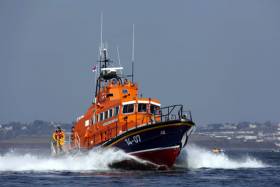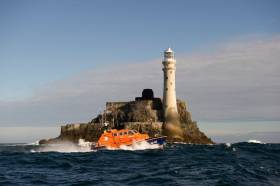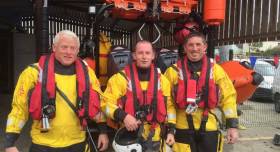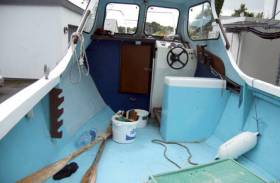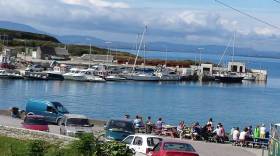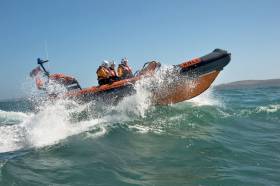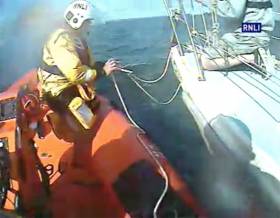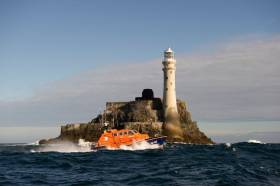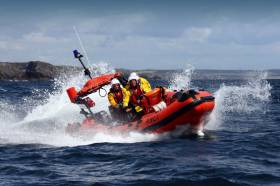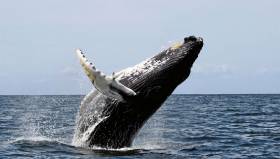Displaying items by tag: west cork
Engine Failure On West Cork Fishing Trip Vessel Prompts Courtmacsherry Lifeboat Rescue
#RNLI - Courtmacsherry RNLI’s all-weather lifeboat was called out at 4.20pm yesterday afternoon (Tuesday 1 August) to go to the aid of a 40ft pleasure fishing boat with mechanical failure 15 miles off the Seven Heads in West Cork.
The Courtmacsherry Lifeboat, under coxswain Kevin Young and with a crew of six, launched in minutes and reached the stricken boat just after 5pm.
On scene near the Lusitania site, the lifeboat secured a tow line to the vessel and then proceeded to tow it back to the safe haven of Courtmacsherry’s inner harbour.
All six on the pleasure boat were safely returned to Courtmacsherry Pontoon at 8pm.
Weather conditions on the callout reasonable, with winds in the area blowing Force 3-4.
The callout was the latest in what was a busy 48 hours for the voluntary crew of Courtmacsherry RNLI, with three callouts to boats in distress beginning on Sunday afternoon with the rescue of another pleasure fishing boat, as previously reported on Afloat.ie.
#RNLI - Baltimore RNLI launched this morning (Friday 28 July) to locate a vessel sending an alarm from their positioning beacon off the coast of West Cork.
The Irish Coast Guard requested the launch just before 10am after it had picked up an alarm from an EPIRB (electronic position indication radio beacon) on a yacht half a mile south west of Cape Clear Island.
Coastguard staff at Mizen Head had no success raising the occupants of the yacht on their VHF so the Baltimore all-weather lifeboat was launched to investigate at the last known co-ordinates of the vessel.
Meanwhile, 10.30am the coastguard finally made contact with the yacht’s two occupants on their VHF and established that the EPIRB had been activated by accident.
Speaking after the callout, Baltimore RNLI volunteer lifeboat navigator Micheal Cottrell said: “It is important to ensure the secure fastening of an EPIRB on board a vessel and to regularly check that it is in good working order. Also, whilst out at sea it is important to keep radio watch on Channel 16.
“If you get into difficulty at sea, call 999 or 112 and ask for the coastguard.”
#RNLI - Union Hall RNLI were alerted by Valentia Coast Guard at 3.24pm yesterday (Saturday 22) to a report of a 30ft yacht with two sailors gone aground at the middle danger in Glandore Harbour, West Cork.
The lifeboat launched and was underway to the yacht at 3.33pm in favourable weather conditions, with a slight breeze from the north.
While en route to the scene, a member of the public notified the lifeboat station that the yacht had refloated safely. The volunteer crew subsequently spoke to the sailors, who were happy to continue sailing.
Union Hall RNLI deputy launch authority Peter Deasy said: “While a lot of activity is taking place in Glandore Harbour this week with the Glandore Classic Boat Regatta, we advise people to be alert, obey navigation aids and respect the water. If you see someone in trouble dial 999/112 and ask for the coastguard.”
#WaterSafety - The dangers of boating without proper safety equipment have been raised by a report into the death of an angler who went overboard from his vessel off West Cork last summer.
The body of Michael O’Brien was recovered on the morning of 15 August 2016, after he was reported missing the previous evening when he failed to return to Schull from a solo fishing trip.
The Marine Casualty Investigation Board (MCIB) report into the incident found that O’Brien, who regularly went angling around Long Island Bay in the summer months, was not wearing a PFD and had no emergency beacon or VHF radio, with only a mobile phone for communication.
It’s unknown how the 69-year-old came to enter the water, but his reduced mobility due to a hip operation and the fact that his crutches were found stowed suggests he used the boat’s bulwarks for support, which would have put his centre of gravity over the edge of the vessel.
The full MCIB report can be downloaded below.
€200,000 Cape Clear Pontoons On the Way for West Cork Island
The good news for West Cork boaters is that the €200,000 pontoons procured for Cape Clear island's North Harbour will be installed this Summer. And as our photo taken this week shows there's little doubt that they will be put to immediate use.
Under the 2017 fishery harbour and coastal infrastructure capital programme, Junior Minister Andrew Doyle told the Dail Harbour's debate in June he had allocated €720,000 for maintenance and development works at the Island's North Harbour. 'The 2017 programme provides €200,000 for pontoons at Cape Clear and €250,000 for the design, preparation of contract documents and planning for additional repair work to Duffy's Pier' he said.
After storm damage wrecked the coastal infrastructure there, construction work has been underway at Cape Clear island since 2014. As Afloat previously reported in March that year, the works have involved the construction of a slipway; replacement of the Bull's Nose structure incorporating a storm gate and an extension to the end of Duffy's Pier; excavation, dredging and reclamation works including the construction of an armoured embankment at the seaward side of the new Bull's Nose structure.
It is expected the Duffy’s Pier preparatory work will also be completed in 2017. However, further work will be subject to permission and funding in future years.
#RNLI - Baltimore RNLI assisted two sailors yesterday afternoon (Friday 14 July) after their motorboat broke down off the coast of West Cork.
The volunteer crew was requested to launch their inshore lifeboat at 2.25pm following a report from the sailors that their vessel had got into difficulty off Toe Head.
Helmed by Youen Jacob and with crew members Pat O’Mahony and Colin Rochford on board, the lifeboat launched immediately and was on scene in 25 minutes.
The 22ft motorboat had broken down half a mile west of Toe Head and had secured an anchor. Weather conditions at the time were relatively good, with a Force 3-4 south-westerly wind and a sea swell of 2-3m.
The lifeboat crew established a tow and brought the vessel safely back to Baltimore Harbour before returning to the station at 4.35pm.
“The sailors did the right thing today requesting assistance when required,” said Baltimore RNLI lifeboat operations manager Tom Bushe. “We would remind everyone enjoying our coast this summer to always respect the water.”
Shore crew in attendance at the station were Rianne and Jerry Smith, Kate Callanan, Marty O’Driscoll and Aidan Bushe.
#RNLI - Union Hall RNLI went to the aid of a yacht with two people onboard yesterday evening (Thursday 13 July) after the vessel got into difficulty half a mile east of Castlehaven Harbour in West Cork.
The volunteer lifeboat crew was alerted at 5.26pm by Valentia Coast Guard to reports of a 28ft yacht that had fouled its propeller.
The lifeboat was launched and on scene within 20 minutes. Weather conditions at the time were good and the sea was calm.
Two whale watching boats, Voyager and Liscannor Star, stood by the casualty vessel until the lifeboat crew arrived and worked with the two men onboard to attach a tow line to the yacht.
The lifeboat then towed the yacht to the safety of Reen Pier before returning to Union Hall, joined by a pod of dolphins along the way.
Speaking following the callout, Union Hall RNLI deputy launching authority Peter Deasy said: “We were happy to assist the sailors this evening on what was the first callout for our only female crew member, Sarah Browne.”
#RNLI - Baltimore RNLI’s volunteer lifeboat crew has responded to three callouts over the last four days.
The first of the three was a medical evacuation from Cape Clear on Friday (7 July).
A woman from the island was suffering from chest pains and needed to be transferred to the mainland, where she was met by a waiting ambulance at the lifeboat station.
The lifeboat was crewed by Kieran Cotter, Sean McCarthy, Cathal Cottrell, Aidan Bushe and Don O’Donovan.
The following night (Saturday 8 July), the lifeboat carried out another medevac, this time from Sherkin Island after man suffered a serious fall from a height and required medical assistance.
The lifeboat crew were assisted on the island by a team led by Dr Jason from West Cork Rapid Response.
The casualty was evacuated to Baltimore, where an ambulance was waiting at the lifeboat station for transfer to hospital in Cork.
Crew on this callout were Kieran Cotter, Pat Collins, Jerry Smith, Don O’Donovan, Brian McSweeney, Jim Griffiths and Ronnie Carthy.
Finally, yesterday morning (Sunday 9 July) Baltimore RNLI’s inshore lifeboat was launched to go to the assistance of a RIB which had broken down off Cape Clear.
Mícheál Cottrell, a helm and crewman with Baltimore RNLI, was out with his sea safari boat on a tour with passengers when he happened upon the boat, with two people onboard, which was suffering engine problems.
Cottrell raised the alarm and Baltimore’s inshore lifeboat was requested to assist.
The lifeboat took the boat in tow to Baltimore, where it was berthed safely and the lifeboat returned to station.
Crew on the inshore lifeboat were helm Youen Jacob, David Ryan and Ryan O’Mahony.
Shore crew in assistance at Baltimore Lifeboat Station were Declan Tiernan, Sean McCarthy, Rianne Smith and Marty O’Driscoll.
Union Hall Lifeboat Starts Summer Season With Two Callouts
#RNLI - It’s shaping up to be the start of a busy season for the volunteer lifeboat crew at Union Hall RNLI with two callouts in less than two weeks.
On Saturday 8 April, the inshore lifeboat launched at 12.14pm to Rabbit Island with reports of two sheep spotted on a low-lying cliff at the side of the island.
The crew went to the island to access the situation, and to eliminate the risk of members of the public trying to assist the sheep.
The volunteers went ashore and helped the sheep back onto the island, left them grazing and returned to Union Hall pier.
More recently, on Monday 17 April, Union Hall RNLI was requested by Valentia Coast Guard at 9.26pm to reports of two red flares spotted near Adam Island at the mouth of Glandore Harbour.
Launching five minutes later, the lifeboat crew proceeded to the scene and were joined by the Irish Coast Guard helicopter Rescue 117 from Waterford and Toe Head/Glandore Coast Guard Unit, who also had their shore crew assist.
A thorough search was conducted of the inner harbour and islands at the mouth of Glandore Harbour. Nothing was found and Union Hall RNLI was stood down at 10.53pm.
Speaking following the callouts, Pamela Deasy, Union Hall RNLI volunteer lifeboat press officer said: “As we approach the summer season we would remind everyone to respect the water and remember if you see anything suspicious or someone in trouble over the coming months, call 112/999 and ask for the coastguard.”
First Humpback Whale Of New 2017 Season Sighted Off West Cork
#MarineWildlife - The first humpback whale sighting for the new season in Irish waters was made last week off the Beara Peninsula.
The Irish Whale and Dolphin Group’s (IWDG) Patrick Lyne was in prime position to witness the unmistakable tail fluke some 5km offshore from Beara in West Cork on the afternoon of Wednesday 5 April.
While not the first humpback sighted this calendar year — that honour goes to a giant spotted off Wexford in early January — it’s still considered the first of the 2017/18 ‘large whale season’.
The sighting also continues a trend of earlier arrivals for Ireland’s regular humpback visitors over recent years, with 2016’s first recorded only four days later and spotted just 4km away.
Last Wednesday was a bumper day for marine wildlife sightings off Co Kerry, too, where Nick Massett spotted at least a dozen minke whales between Ventry, Slea Head and the Blaskets.
Many of these locations feature in Colin Stafford-Johnson’s new BBC TV series Wild Ireland, as BBC News reports. The two episodes are currently streaming via the BBC iPlayer, where available.
In other cetacean news, researchers believe that whale strandings may in part be caused by exhaustion when cetaceans flee human-made noise in the ocean.
According to the Irish Independent, a study by marine scientists at UC Santa Cruz found that beaked whales startled by low-frequency sonar raise their energy consumption by almost a third, increasing demands on their limited oxygen supply while below the surface.
The news will be fuel to those who suspect human activity at sea plays a major role in increased cetacean stranding rates.
As previously reported on Afloat.ie, 2017 became the worst year on record for whale and dolphin strandings by mid February.


























